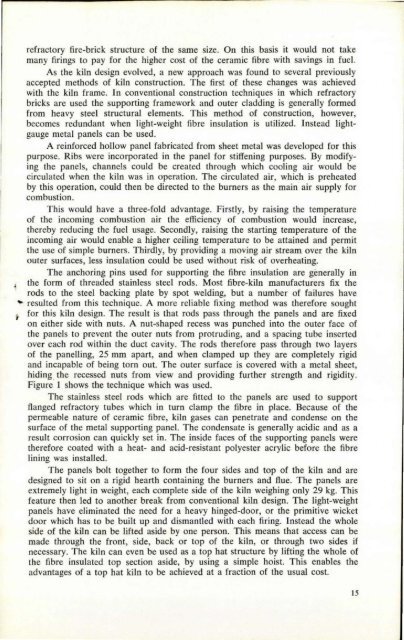Pottery in Australia Vol 17 No 1 Autumn 1978
Create successful ePaper yourself
Turn your PDF publications into a flip-book with our unique Google optimized e-Paper software.
efractory fire-brick structure of the same size. On this basis it would not take<br />
many fir<strong>in</strong>gs to pay for the higher cost of the ceramic fibre with sav<strong>in</strong>gs <strong>in</strong> fuel.<br />
As the kiln design evolved, a new approach was found to several previously<br />
accepted methods of kiln construction. The first of these changes was achieved<br />
with the kiln frame. In conventional construction techniques <strong>in</strong> which refractory<br />
bricks are used the support<strong>in</strong>g framework and outer cladd<strong>in</strong>g is generally formed<br />
from heavy steel structural elements. This method of construction, however,<br />
becomes redundant when light-weight fibre <strong>in</strong>sulation is utilized. Instead lightgauge<br />
metal panels can be used.<br />
A re<strong>in</strong>forced hollow panel fabricated from sheet metal was developed for this<br />
purpose. Ribs were <strong>in</strong>corporated <strong>in</strong> the panel for stiffen<strong>in</strong>g purposes. By modify<strong>in</strong>g<br />
the panels, channels could be created through which cool<strong>in</strong>g air would be<br />
circulated when the kiln was <strong>in</strong> operation. The circulated air, which is preheated<br />
by this operation, could then be directed to the burners as the ma<strong>in</strong> air supply for<br />
combustion.<br />
This would have a three-fold advantage. Firstly, by rais<strong>in</strong>g the temperature<br />
of the <strong>in</strong>com<strong>in</strong>g combustion air the efficiency of combustion would <strong>in</strong>crease,<br />
thereby reduc<strong>in</strong>g the fuel usage. Secondly, rais<strong>in</strong>g the start<strong>in</strong>g temperature of the<br />
<strong>in</strong>com<strong>in</strong>g air would enable a higher ceil<strong>in</strong>g temperature to be atta<strong>in</strong>ed and permit<br />
the use of simple burners. Thirdly, by provid<strong>in</strong>g a mov<strong>in</strong>g air stream over the kiln<br />
outer surfaces, less <strong>in</strong>sulation could be used without risk of overheat<strong>in</strong>g.<br />
The anchor<strong>in</strong>g p<strong>in</strong>s used for support<strong>in</strong>g the fibre <strong>in</strong>sulation are generally <strong>in</strong><br />
the form of threaded sta<strong>in</strong>less steel rods. Most fibre-kiln manufacturers fix the<br />
rods to the steel back<strong>in</strong>g plate by spot weld<strong>in</strong>g, but a number of failures have<br />
.. resulted from this technique. A more reliable fix<strong>in</strong>g method was therefore sought<br />
; for this kiln design. The result is that rods pass through the panels and are fixed<br />
on either side with nuts. A nut-shaped recess was punched <strong>in</strong>to the outer face of<br />
the panels to prevent the outer nuts from protrud<strong>in</strong>g, and a spac<strong>in</strong>g tube <strong>in</strong>serted<br />
over each rod with<strong>in</strong> the duct cavity. The rods therefore pass through two layers<br />
of the panell<strong>in</strong>g, 25 mm apart, and when clamped up they are completely rigid<br />
and <strong>in</strong>capable of be<strong>in</strong>g tom out. The outer surface is covered with a metal sheet,<br />
hid<strong>in</strong>g. the recessed nuts from view and provid<strong>in</strong>g further strength and rigidity.<br />
Figure 1 shows the technique which was used.<br />
The sta<strong>in</strong>less steel rods which are fitted to the panels are used to support<br />
flanged refractory tubes which <strong>in</strong> turn clamp the fibre <strong>in</strong> place. Because of the<br />
permeable nature of ceramic fibre, kiln gases can penetrate and condense on the<br />
surface of the metal support<strong>in</strong>g panel. The condensate is generally acidic and as a<br />
result corrosion can quickly set <strong>in</strong>. The <strong>in</strong>side faces of the support<strong>in</strong>g panels were<br />
therefore coated with a heat- and acid-resistant polyester acrylic before the fibre<br />
l<strong>in</strong><strong>in</strong>g was <strong>in</strong>stalled.<br />
The panels bolt together to form the four sides and top of the kiln and are<br />
designed to sit on a rigid hearth conta<strong>in</strong><strong>in</strong>g the burners and flue. The panels are<br />
extremely light <strong>in</strong> weight, each complete side of the kiln weigh<strong>in</strong>g only 29 kg. This<br />
feature then led to another break from conventional kiln design. The light-weight<br />
panels have elim<strong>in</strong>ated the need for a heavy h<strong>in</strong>ged-door, or the primitive wicket<br />
door which has to be built up and dismantled with each fir<strong>in</strong>g. Instead the whole<br />
side of the kiln can be lifted aside by one person. This means that access can be<br />
made through the front, side, back or top of the kiln, or through two sides if<br />
necessary. The kiln can even be used as a top hat structure by lift<strong>in</strong>g the whole of<br />
the fibre <strong>in</strong>sulated top section aside, by us<strong>in</strong>g a simple hoist. This enables the<br />
advantages of a top hat kiln to be achieved at a fraction of the usual cost.<br />
15


















